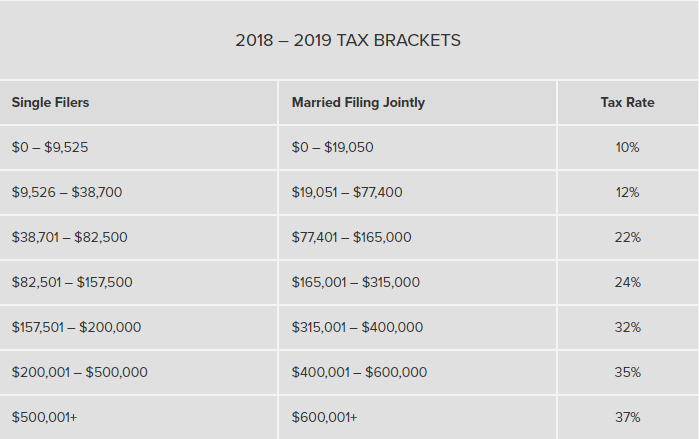File Taxes under Trumps new Tax Plan
President Trump signed a new tax bill, the Tax Cuts and Jobs Act, into law in December 2017. This bill largely didn’t affect individual income taxes until the 2018 tax year, which you file in early 2019. How exactly the Trump tax plan affects you depends on your income, your current filing status and the deductions you take. Take a look at the following guide to help you better understand the main features of the new tax plan.
A Brief History of the New Tax Plan
In 2017, House Republicans and President Trump worked to introduce a tax bill that would simplify the tax system. They unveiled their long-awaited tax bill, the Tax Cuts and Jobs Act (TCJA), on Nov. 2, 2017. The bill called for sweeping changes to the current tax law.
The House passed the final version of the bill on Dec. 20, 2017, with a final tally of 224-201. Twelve House GOP members and all Democrats opposed the legislation. Originally, the House passed the bill on Dec. 19, but a re-vote was necessary because several provisions of the bill reportedly violated Senate rules and needed to be removed. The Senate passed the corrected version of the bill in the early morning hours of December 20, voting 51-48 along party lines. President Trump then signed the bill into law on Dec. 22, 2017.
Most of the tax changes in the TCJA went into effect in January 2018, for the 2018 tax year. That means the changes didn’t affect many 2017 tax returns (you filed 2017 taxes in early 2018). Employees didn’t see changes in their paycheck withholding until February 2018.
New Trump Tax Brackets – Still 7 Total
Trump’s tax plan originally called for cutting the number of tax brackets in the federal income tax system from seven to four, but the final version of the bill maintains the seven brackets. It does, however, change their rates.
Previously, the tax brackets went up to a top rate of 39.6%. The new tax brackets, which apply as of January 2018, have rates of 10%, 12%, 22%, 24%, 32%, 35% and 37%. These rates affect income you receive during tax year 2018. When you file in early 2019, these are the rates that determine your tax bill.
The table below breaks down the brackets for single and joint filers. If you use have a different filing status, make sure to read our full breakdown of the current tax brackets.
The Trump Tax Plan Increased the Standard Deduction
There are deductions to consider as well. The new tax plan nearly doubled the standard deduction for all filers. If you’re a single filer or if you’re married filing separately, your standard deduction for 2018 is $12,000. Joint filers have a deduction of $24,000 and heads of household get $18,000.
TAX YEAR 2017 STANDARD DEDUCTIONSSingle FilersMarried Filing Jointly$6,350$12,700TAX YEAR 2018 (TRUMP PLAN) STANDARD DEDUCTIONSSingle FilersMarried Filing Jointly$12,000$24,000Big Changes to State and Local Tax Deductions (SALT)
During initial talks, Republicans called for eliminating almost all itemized deductions, including state and local tax (SALT) deductions, but keeping those for charitable deductions and mortgage interest. Ultimately, the TCJA capped SALT deductions to $10,000.
Previously, taxpayers who itemized could deduct their state and local income, property and general sales tax payments on their federal tax returns. This was especially useful for residents of high-tax states like California and New Jersey. If you think this change could alter your taxes, make sure you read up on the new rules of SALT deductions.
Trump Tax Plan Changes to the Mortgage Interest Deduction
For tax year 2017, homeowners who itemized their deductions could deduct their mortgage interestpayments on mortgages up to $1 million. For 2018 and beyond, the new limit on this deduction is $750,000. If you’re married filing separately, your limit is $375,000 in mortgage interest.
Child Tax Credits Saw Big Changes
Under the new tax plan, the Child Tax Credit (CTC) is worth $2,000 per child under 17. The credit used to be $1,000. The credit is now available to more taxpayers, too. Previously, the credit began to phase out once you had income of $75,000 ($110,000 for joint filers). You now qualify to receive the full credit if your income is up to $200,000 ($400,000 for joint filers). The CTC is also refundable now up to $1,400. That means if the CTC brings your tax liability below zero, the IRS will send you a refund for the credit, up to $1,400. It was not refundable in the past so if it brought your liability below zero, you simply would owe nothing and would get no refund.
The adoption credit also remains in effect and is worth up to $13,750 per child.
Trump Tax Plan Doubles the Estate Tax Deduction
Under current law, the estate tax(40%) applies when multimillionaires transfer property to heirs. The Trump tax plan doubles the estate tax deduction from the 2017 value of $5.49 million for individuals up to $11.18 million. This higher limit allows wealthy families to transfer more money tax-free to their heirs.
Trump Tax Plan Lowers Corporate Tax Rate
Before 2018, the corporate tax rate was 35%. The TCJA reduced the rate to 21%. This flat rate applies to all corporate income (of at least $1).
Bottom Line
The U.S. tax code isn’t always the most straightforward and things can get more confusing when there are changes from one year to the next. The Tax Cuts and Jobs Act made some big changes to the tax code, particularly to deductions and the tax brackets. It’s a good idea to review the new changes, especially if you usually itemize deductions. (We also took a look at who should itemize under the new tax plan.)
When you go through your first tax filing with the new laws, it’s a good idea to use a good tax filing service. We did our annual roundup of the best tax filing software so that you can get through this tax season as painlessly as possible.
Another option to consider is working with a financial advisor. A financial advisor who specializes in taxes can help you navigate the changes to the law. This is especially useful if you have a complicated tax situation or if you usually itemize deductions. To make finding an advisor as simple as possible, we created a tool to match you with a financial advisor in your area. Just answer some questions about your financial situation and goals, and you’ll be matched with up to three advisors in your area who can provide expertise based on your profile and goals. You can then check out the advisors’ profiles, interview them on the phone or in person and choose who to work with.
Source - https://smartasset.com/taxes/heres-how-the-trump-tax-plan-could-affect-you
Photo credit: ©iStock.com/Dean Mitchell, ©iStock.com/Geber86, ©iStock.com/Juanmonino



